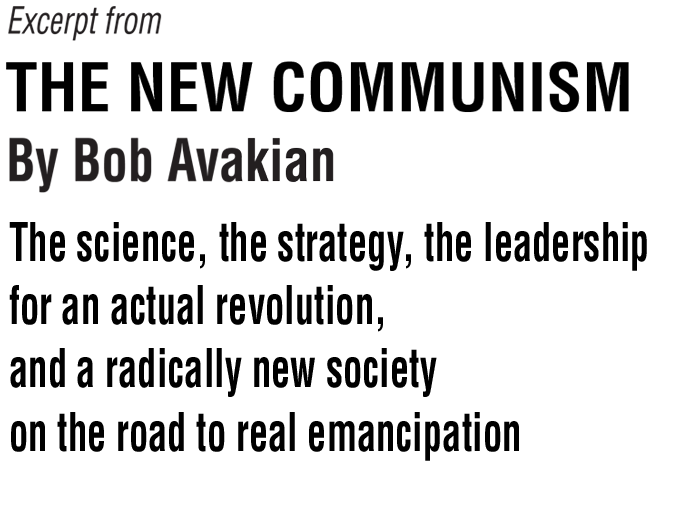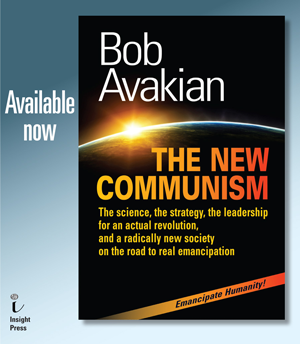
Editors' note: The following is an excerpt from the new work by Bob Avakian, THE NEW COMMUNISM. In addition to excerpts already posted on revcom.us, we will be running further excerpts from time to time on both revcom.us and in Revolution newspaper. These excerpts should serve as encouragement and inspiration for people to get into the work as a whole, which is available as a book from Insight Press. An updated pre-publication PDF of this major work—now including the appendices—is available here.
This excerpt comes from the section titled "IV. The Leadership We Need."
Forms of Revolutionary Organization, and the “Ohio”
Besides the Party, which is the most important form of organization of the masses, in relation to their fundamental need for a revolution whose ultimate aim is a communist world, there are other important forms of revolutionary organization. There are the Revolution Clubs, which is an important form of basic revolutionary organization of masses, particularly when they are new to the revolution. Now, again, if people come into this and stay in the same place, and kind of find a niche, a little resting place, for years and years, that’s a problem—that means we’re not doing what we need to do. Not everybody is going to advance forward. Some people are going to learn more about this and decide they don’t want to be part of it, because they don’t want to give their lives to this, even if they’re sympathetic. At the same time, many people should be moving forward. But, particularly for people who are newer, the Revolution Clubs embody a means for them to take part in the revolution in an organized way, while they are learning more about this.
There is an important role for this kind of organization in terms of “representing” for the revolution: boldly putting forward this revolution, being a “pole of attraction,” drawing growing numbers of people around and into the ranks of the revolution, and popularizing the leadership for this revolution (the Party and BA). And there is a role for the Revolution Clubs as what we might call a “conveyor belt” to the Party. Now, that may be sort of a crude metaphor, but what it speaks to is that the Revolution Clubs should provide a way for people to work through the contradictions they are confronting, as they are taking part, in an organized way, in the revolution, with many of them moving toward the Party and getting to the point where they want to, and should, become part of the Party and contribute to the revolution in that way, and on that level, which is yet a higher level than something like the Revolution Clubs.
So, here is a question about the Revolution Clubs: How does “solid core with a lot of elasticity on the basis of the solid core” apply to building the Revolution Clubs, with their two main slogans: “Humanity Needs Revolution and Communism” and “Fight the Power, and Transform the People, for Revolution”?
Now, in addition to the Revolution Clubs, we need to have a living and creative orientation toward the emergence or development of other forms of revolutionary organization among the masses. It’s not that the Revolution Clubs are unimportant—they are very important. But we shouldn’t have a stereotyped approach to things. In the course of the upheavals that are going to go on, and people rising up, and in the course of our working and struggling with people, they may suggest other forms of organization, or themselves work to bring into being other forms of organization, which are expressions of the same basic revolutionary line; and, as opposed to having a rigid approach to this—as if everything has to be just one way, and the development of new forms of revolutionary organization is somehow a problem—we should have an open and creative approach toward the development of different forms of revolutionary organization as things unfold, while continuing to recognize, and to give expression to, the importance of the Revolution Clubs. Here’s the important point: All this needs to be guided, in a fundamental sense, by the same overall line and the same strategic goal—in other words, the same solid core.
This brings me to what we call the “Ohio.” This is a metaphor that was developed by some of us who are football fans. Way back in the day, we watched the Ohio State marching band performing at halftime of football games. They had this script “Ohio” that they spelled out (and I see that they still do this): They start with the “O,” and individual members of the band are marching through as they form the “O”; then the ones who have been part of the “O” go on and start forming the “H”; and then they move on to form the “I”; and then the last “O.” Meanwhile, other people come in and take over the first “O”—and so on it goes. If you look at the script “Ohio” being spelled out, there are people at every point, in each of the letters, but it’s not all the same people in the same place. They’re moving through it. So we adopted this as a metaphor for the process that needs to go on, where things have, at any given time, an actual identity, while people are moving through them. In other words, a revolutionary movement at any given time has an identity, in the way this “Ohio” does, as people are moving through it, but it’s not always the same people remaining in the same place. People are supposed to be moving through it. (Otherwise, if the band did this script “Ohio,” and the first group of people didn’t move, you wouldn’t have the word “Ohio”—you’d just have one big mess.)
Now, it might seem somewhat silly to draw from things like a band performance at football games, but that just illustrates the principle that we can and should draw from all different parts of life. And this is actually a helpful metaphor: It gets at both the fact that there’s a need for, and an identity to, organized forms through which people can be part of and contribute to the revolution, while they are continuing to learn and are in motion, but also that this will turn into its opposite if, in an overall sense, people only go so far and then get stuck in the same place. The point is for many of them to be moving through this and advancing more and more along the path toward joining the Party; and work and struggle should be carried out with them, with that orientation and that objective in mind—helping them to advance to the point where they meet the criteria and standards for being in the Party, and on that basis join the Party and continue to develop, and to contribute, in the context of being in the Party.
Now, again, some people may come to more clearly understand what this is all about and say, “Well, I don’t wanna devote my life to that, I wanna fall back and do something else, or be supportive in a less involved and committed way.” OK, we should find the ways to work with people like that, to the degree that we can. But many people should be moving forward, even while this movement, and organized forms like the Revolution Clubs, have their identity.
The same basic principles apply to people who are in the Party. I referred earlier to the point that is emphasized in the Interview with Ardea Skybreak—that it’s no good if people are in the Party for years and decades and they stay on the same level. If you’ve been in the Party for a long time, and you’re still just on the same basic level as when you joined—doing the same thing you did years ago—something’s very wrong! Where’s the “Ohio” as applied to that? This is another principle and another contradiction that we have to grapple with.
Contents
Publisher's Note
Introduction and Orientation
Foolish Victims of Deceit, and Self-Deceit
Part I. Method and Approach, Communism as a Science
Materialism vs. Idealism
Dialectical Materialism
Through Which Mode of Production
The Basic Contradictions and Dynamics of Capitalism
The New Synthesis of Communism
The Basis for Revolution
Epistemology and Morality, Objective Truth and Relativist Nonsense
Self and a “Consumerist” Approach to Ideas
What Is Your Life Going to Be About?—Raising People’s Sights
Part II. Socialism and the Advance to Communism:
A Radically Different Way the World Could Be, A Road to Real Emancipation
The “4 Alls”
Beyond the Narrow Horizon of Bourgeois Right
Socialism as an Economic System and a Political System—And a Transition to Communism
Internationalism
Abundance, Revolution, and the Advance to Communism—A Dialectical Materialist Understanding
The Importance of the “Parachute Point”—Even Now, and Even More With An Actual Revolution
The Constitution for the New Socialist Republic in North America—
Solid Core with a Lot of Elasticity on the Basis of the Solid Core
Emancipators of Humanity
Part III. The Strategic Approach to An Actual Revolution
One Overall Strategic Approach
Hastening While Awaiting
Forces For Revolution
Separation of the Communist Movement from the Labor Movement, Driving Forces for Revolution
National Liberation and Proletarian Revolution
The Strategic Importance of the Struggle for the Emancipation of Women
The United Front under the Leadership of the Proletariat
Youth, Students and the Intelligentsia
Struggling Against Petit Bourgeois Modes of Thinking, While Maintaining the Correct Strategic Orientation
The “Two Maximizings”
The “5 Stops”
The Two Mainstays
Returning to "On the Possibility of Revolution"
Internationalism—Revolutionary Defeatism
Internationalism and an International Dimension
Internationalism—Bringing Forward Another Way
Popularizing the Strategy
Fundamental Orientation
Part IV. The Leadership We Need
The Decisive Role of Leadership
A Leading Core of Intellectuals—and the Contradictions Bound Up with This
Another Kind of “Pyramid”
The Cultural Revolution Within the RCP
The Need for Communists to Be Communists
A Fundamentally Antagonistic Relation—and the Crucial Implications of That
Strengthening the Party—Qualitatively as well as Quantitatively
Forms of Revolutionary Organization, and the “Ohio”
Statesmen, and Strategic Commanders
Methods of Leadership, the Science and the “Art” of Leadership
Working Back from “On the Possibility”—
Another Application of “Solid Core with a Lot of Elasticity on the Basis of the Solid Core”
Appendix 1:
The New Synthesis of Communism:
Fundamental Orientation, Method and Approach,
and Core Elements—An Outline
by Bob Avakian
Appendix 2:
Framework and Guidelines for Study and Discussion
Notes
Selected List of Works Cited
About the Author
 Download PDF of entire work
Download PDF of entire work